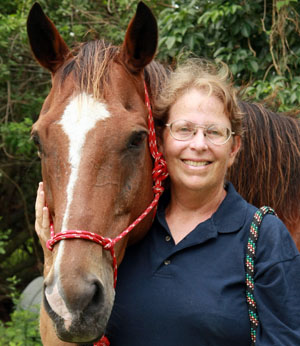TALES FROM THE TRAILS
Growing up in Russia, Natalia Elina was 5 when she saw her first horse.
“Like many Russians, my family spent the summer in the country at a dacha, a kind of summer house,” she recalled. “We visited with friends who lived next to a park, and someone rode by on a huge gray draft horse. That was it. As soon as I saw that horse, I knew that was what I wanted. My parents laughed but brought me over. They lifted me up and gave me a ride, holding me in place. I pushed their hands away. I wanted to ride by myself.”
Natalia’s mother was deathly afraid of big horses, but Natalia was determined that riding would be in her life. Back then, in the 1970s, the Soviet Union allowed anyone to attend any sport school they chose for free. A youngster simply showed up, spoke to the coach, and that was that.
“All you needed was a note from a doctor saying you were physically OK, and a permission letter from your parents,” Natalia said. “The thing is, you had to be committed to the sport. If you skipped a class, they threw you out. My mom thought I was going to an art school. I forged the permission letter. I was 15.”
The class was all English riding with a German-based hunter/jumper curriculum — 20 kids, 20 horses, cleaning stalls and riding two hours every day after school.
“You rode whatever horse you were assigned,” Natalia said. “No arguing. Some of those horses were really fresh. They might have been standing in a stall for three days. It didn’t matter. It was like a boot camp. You weren’t allowed to complain that you hurt. One time I forgot and left a brush in a horse’s stall when I finished grooming him. I had to clean three more stalls. I never forgot a brush again.”
Skip forward to 2002. Natalia married her husband, an American. They lived in South Florida for a year, then New Jersey, where he had family. Natalia worked as an art director in an animation studio. They moved to Fort Lauderdale, then to The Acreage in 2008.
“When we moved here, the first thing I did was buy a Quarter Horse,” Natalia smiled. “Finally, we were living in an equestrian area, and I was going to have my own horse. I had waited 20 years. I wasn’t going to wait any longer.”
Lacy was a dark bay 5-year-old. Natalia kept the horse at home.
“I liked her a lot the first time I saw her. I liked the way she looked at me,” Natalia recalled. “She’s the friendliest thing. She knocks on the door. But she’s a mare, so she can be moody. And she was green. I started riding with a friend, Linda Rainbolt, and she convinced me to do the local shows just for fun.”
And that’s where Natalia met Jon Ingram fours ago.
“I watched him ride at the show. It was incredible,” she recalled. “I was having a lot of trouble getting Lacy to take her right lead, so I asked him to help me. He was so sweet. He trailered her to his place in Loxahatchee. It was awesome. Now I train with him. He’s very generous.”
Natalia didn’t quite know exactly what she was getting into. “Of course, Jon is very famous in the world of reining, and I didn’t know the first thing about that,” she said. “He’s very authentic and knowledgeable, straightforward. What you see is what you get. It’s completely different. Cow horses remain calm and unstressed. I was fascinated at how he achieved that.”
She suggested doing a movie about Ingram and his methods, and he eventually agreed.
“I convinced a friend in Ohio to come down and film it. She shot the raw footage in two weeks in early 2012,” Natalia said. “I did all the editing, which took seven months. I wanted to capture a sense of his process, his daily routine with the horses, his craftsmanship and dedication to getting the little things perfect.”
Natalia’s problem is the length of her film. At 52 minutes, it’s too short to be a feature and too long for short film festivals, which require films of 30 minutes or less. If she can raise some additional money, she hopes to be able to re-edit it while maintaining its integrity.
“Reining is fascinating, and not a lot of people know too much about it,” she said. “I wanted to capture the feel for Jon and reining. Reining is good for all horses, whatever their discipline. It improves their mood, balance and strength. It’s like yoga for horses.”
As for Lacy, Natalia said that she has greatly improved since working with Ingram. “Jon taught her to relax,” Natalia said. “She has gears now; she’ll go any speed I want. Reining has helped her reset her brain from excited to calm.”
Natalia’s film, It’s Reining, is available on DVD for $25. Contact her at (908) 447-0790 or animacat@gmail.com. Watch clips from the film at www.vimeo.com/itsreining/videos.








